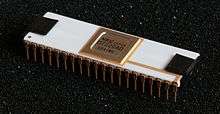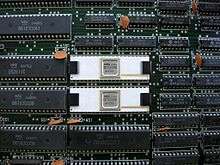NEC µPD7220
The High-Performance Graphics Display Controller 7220 (commonly μPD7220 or NEC 7220) is a video display processor capable of drawing lines, circles, arcs, and character graphics to a bit-mapped display. It was developed by NEC in order to support the Kanji character set efficiently, which explains why the APC computer line had such superior graphics compared to competing models. The chip was also used in later computers, such as NEC's PC-9801 and the NEC APC II and APC III computers, the NEC N5200 intelligent kanji terminal, the optional graphics module for the DEC Rainbow, the Tulip System-1, and the Epson QX-10.[1]
| Release date | 1980 |
|---|---|
| History | |
| Successor | μPD72120 Advanced Graphics Display Controller |


The μPD7220 was one of the first implementations of a graphics display processor as a single Large Scale Integration (LSI) integrated circuit chip, enabling the design of low-cost, high-performance video graphics cards such as those from Number Nine Visual Technology. It was one of the best known graphics chips of the 1980s.[2]
Details

The project was started in 1979, and appeared in NEC's "Advanced Personal Computer" or "APC" in 1980. The NEC APC sported a 5 MHz Intel 8086 processor on a 16-bit bus, and came with a text-only display board using this chip. An optional graphics-only display board "merged" the text and graphics video through an XOR port in HW. The only OS on the original NEC APC was the UCSD p-System, but later on (in 1982) CPM/86 support was added. In 1981, an English language paper written in 1980 by Tetsuji Oguchi, Misao Higuchi, Takashi Uno, Michiori Kamaya and Munekazu Suzuki was published in the IEEE.[3] Nippon Electric Company (now NEC) deployed the chip in other computers, such as the NEC PC-9801, and NEC's APC II and later APC III computers, and also released it to other manufacturer's in Japan, starting in 1982. The same year, the 7220 was revealed in North America by NEC Information Systems, the US arm of NEC. By 1983, it was used in other early computers, from NEC and other companies including Digital Equipment Corporation and Wang Laboratories.[4]
A few years after its introduction, one journalist said "The 7220 GDC chip is a component that even some of NEC's competitors have found too good to pass up."[4] When the Apple Lisa was announced in 1983, the press raised questions on why the popular 7220 was not used.[5][6] Bruce Daniels pointed out that the Lisa primarily used raster graphics (known as bitmap graphics at the time), which could be implemented with less expensive hardware support. Instead, graphics primitives were written in software. Development manager Wayne Rosing added that although the team knew about the 7220, it was not quite available when the design began. There were also restrictions on when the display memory could be accessed: only during certain times in the vertical refresh cycle.[5]
Variants
Variants included:
- Intel licensed the design and called it the 82720 graphics display controller.[7] Announced in 1982, it was the first of what would become a long line of Intel graphics processing units.[8][9]
- East Germany (the German Democratic Republic) produced a replica designated U82720, used with the U880 replica of the Zilog Z80.[10]
- The faster complementary metal–oxide–semiconductor (CMOS) variant was given the designation μPD72020.
- A follow-on project produced the μPD72120 Advanced Graphics Display Controller (AGDC) which was faster and supported a 16-bit interface. It was named one of the "Top 100" products of 1987 by Electronics Design.[11]
Internals
Two I/O channels are used, addressing A0 and A1. Reading A0 retrieves the 7220 status. Reading A1 fetches the first byte from the internal queue. Writing to the 7220 uses both registers; A1 for writing the command, A0 for writing the parameters to the queue.[1] The parts had an 8-bit data path.[12] Parts were available with clocks running from 4 MHz to 5.5 MHz, which was considered relatively high-performance for the time.[6]
References
- Dampf, Guido (1986). "Graphics with the NEC 7220: Direct access with Turbo Pascal". Retrieved 27 July 2013. (Translation of "Grafik mit dem 7220 von NEC", mc, 1986, H11, pp. 54-65)
- F.Robert A. Hopgood, Roger J. Hubbold, David A. Duce, eds. (1986). Advances in Computer Graphics II. Springer. p. 169. ISBN 9783540169109.
Perhaps the best known one is the NEC 7220.
CS1 maint: uses editors parameter (link) - Tetsuji Oguchi; Misao Higuchi; Takashi Uno; Michiori Kamaya; Munekazu Suzuki (February 1981). "A Single-chip Graphic Display Controller" (PDF). International Solid State Circuit Conference. IEEE: 170–171. doi:10.1109/ISSCC.1981.1156160.
- David Needle (March 21, 1983). "NEC's 7220 GDC chip allows high-resolution color graphics". Info World. pp. 31–34. Retrieved July 29, 2013.
- Wayne Rosing, Bruce Daniels, and Larry Tesler (February 1983). "An Interview with Wayne Rosing, Bruce Daniels, and Larry Tesler: A behind-the-scenes look at the development of Apple's Lisa". Byte Magazine. pp. 90–114. Retrieved July 29, 2013.CS1 maint: multiple names: authors list (link)
- Hal W. Hardenberg (April 1983). "An Introduction to the 7220". DTACK Grounded. Digital Acoustics. pp. 8–9. Retrieved July 31, 2013.
- Changon Tsay (January 1, 1986). A graphics system design based on the INTEL 82720 graphics display controller. Dissertation. University of Texas at El Paso.
- "Intel Corporation Annual Report" (PDF). Intel. 1982. Retrieved July 27, 2013.
- 82720 GDC Application Manual (PDF). Intel, reprinted from NEC. July 1983. Retrieved April 11, 2020.
- "Integrierte Schaltkreise: Schaltkreis U82720". Robotron Technik. Retrieved July 27, 2013. (in German)
- "Graphics Display Controller simplifies programming" (PDF). Electronics Design. May 14, 1987. p. 106.
- "μPD7220/GDC, μPD7220-1/μPD7220-2 Graphics Display Controller" (PDF). The data sheet. NEC. April 7, 1983. Retrieved July 29, 2013.
External links
- uPD7220/uPD7220A User Manual, December 1985
- Source code of driver for CP/M-86
- 7220 and 72020 data sheets
- "Article on μPD7220" (PDF). Nikkei Electronics. (in Japanese)